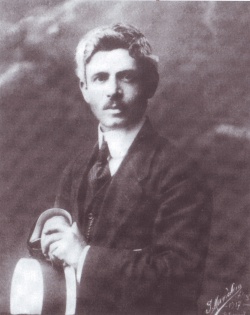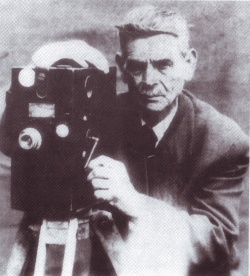Difference between revisions of "Yanaki and Milton Manaki"
Sorindanut (talk | contribs) |
Sorindanut (talk | contribs) |
||
| Line 59: | Line 59: | ||
* Marian Ţuţui, ''Fraţii Manakia şi imaginea Balcanilor'', Bucharest: Editura Noi Media Print, 2009 (in Romanian). | * Marian Ţuţui, ''Fraţii Manakia şi imaginea Balcanilor'', Bucharest: Editura Noi Media Print, 2009 (in Romanian). | ||
* Goran Trenčovski, "[http://www.filmfestival-goeast.de/index.php?article_id=194&clang=1 A View Of The Macedonian Documentary Film]". | * Goran Trenčovski, "[http://www.filmfestival-goeast.de/index.php?article_id=194&clang=1 A View Of The Macedonian Documentary Film]". | ||
| + | * Igor Stardelov, [http://www.fiafnet.org/pdf/uk/fiaf54.pdf "Preservation of Manaki Brothers Film Heritage" ], ''Journal of Film Preservation'', April 1997, 26:54:27-30. | ||
== External links== | == External links== | ||
Revision as of 07:36, 7 April 2014
 Photo of Ienache Manakia, 1917. | |
| Born |
May 18, 1878 Avdella, Ottoman Empire (today northern Greece) |
|---|---|
| Died |
May 19, 1954 (aged 76) Thessaloniki, Greece |
 Milton Manakia in a scene from the movie Camera 300. | |
| Born |
May 18, 1878 Avdella, Ottoman Empire (today northern Greece) |
|---|---|
| Died |
May 19, 1954 (aged 76) Bitola, Yugoslavia |
The brothers Ianachia (Ion, Ionel, Ianakis, Ianaki sau Iovan, 1878–1954) and Milton Manachia (Miltiade, Maltu, 1882–1964) were pioneering photographers and the early filmmakers in the Balkans.
Contents
Photography
They began to work together in 1898. Ienache opened an photographic studio in Epir, where he worked as a teacher of drawing and calligraphy.
In 1903 they captured still images of a popular uprising for the newspaper Universul.[1]
Milton had to leave Ianina in 1905 after the scandal of Vouvousa and they moved to Bitola (Monastir) in Macedonia where they opened the famous Studio of Art and Photography. The studio used the label in two language, Romanian and Turkish, the official language of the Ottoman Empire.
The Manakis brothers became the official photographers of the Romanian Court Royal in 1906, of the Ottoman in 1911 and of king Aleksandar Karadjordevic in 1929.
In total, they took over 17,300 photographs in 120 localities.
Film
They successfully exhibited their work at the 1906 International Exhibition in Bucharest, where they saw the cinematographic camera for the first time.[2]
The two bought a Bioscope 300 (35mm) camera from the Charles Urban & Co. firm during a trip that took them from Paris to London, owing to a grant from King Karol I. During the same year they made a documentary film, Household Traditions of the Romanian-Macedonian Women from Pind, soon followed by several other productions showing popular dances, religious rituals, weddings, and funerals of the same region, which can be considered among the first ethnographic films in the world. [3] (Rudolf Pöch's ethnographic films from New Guinea are from 1904.) One of their films, The Weavers [Viaţa casnică la aromâncele din Pind] (c1906) is a silent, black and white documentary short made in the small Aromanian village of Avdella, in the Ottoman vilayet of Monastir. It depicts the Manaki's aunts and 114-year-old grandmother Despina spinning and weaving. It is said to be the first film shot in the Ottoman Balkans.
The Manaki brothers also pioneered the longer newsreel film by recording the visits of Sultan Mehmed Rashid V to Salonika and Bitola in 1911.[4]
Awards
- 2 gold medals and 1 silver medal at the International Exhibition in Bucharest, 1906.
Legacy
In honor of their work, the International Cinematographers' Film Festival "Manaki Brothers" (founded in 1979 and renamed to "Manaki Brothers" in 1993) is held every year in Bitola, the city where most of their activities were organized. The film award is named "Room 300" [Camera 300].
Documentary films about the Manakis brothers
- Room 300 [Camera 300], short film by the Croatian director Branko Ranitović, 1958.
- The Manakis brothers - the Balkan pioneers [Fratii Manakia - pionierii din Balcani], dir. Manuela Tanase, screenplay: Marian Ţuţui, 1995.
- The Manakis brothers [Fratii Manakia], dir. Sabina Pop, screenplay: Marian Ţuţui, 2002. Co-production of the national televisions of Macedonia, Albania and Romania.
See also
- Macedonia#Early cinema
- Albania# Early cinema
- Romania#Early cinema
- Greece#Early cinema
- Turkey#Early cinema
Literature
- Marian Ţuţui, Orient Express: filmul românesc şi filmul balcanic sau Cinematograful balcanic, Bucharest: Editura Noi Media Print, 2008. (in Romanian)
- Marian Ţuţui, Fraţii Manakia şi imaginea Balcanilor, Bucharest: Editura Noi Media Print, 2009 (in Romanian).
- Goran Trenčovski, "A View Of The Macedonian Documentary Film".
- Igor Stardelov, "Preservation of Manaki Brothers Film Heritage" , Journal of Film Preservation, April 1997, 26:54:27-30.